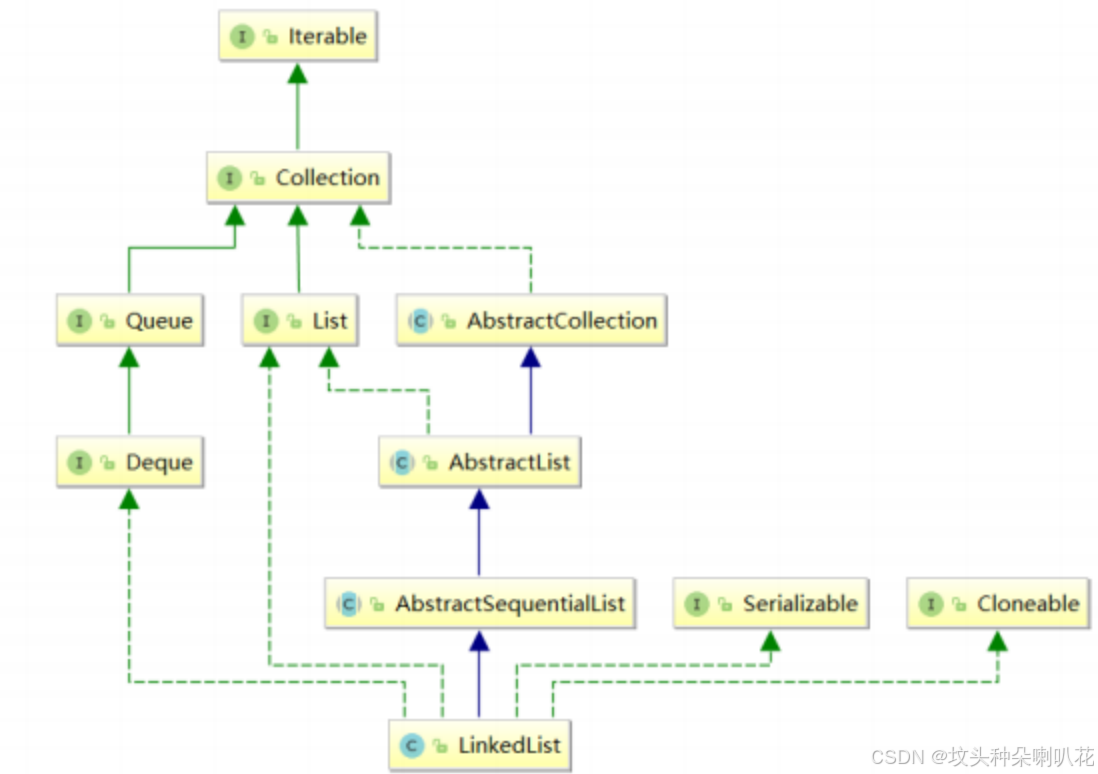目录
一、链表
链表是一种物理存储结构上非连续存储结构,数据元素的逻辑顺序是通过链表中的引用链接次序实现的
- 链式结构在逻辑上是连续的,但是在物理上不一定连续
- 现实中的结点一般是从堆上申请出来的
- 从堆上申请的空间是按照一定的策略来分配的,两次申请的空间可能连续也可能不连续
链表的结构多种多样,就单向/双向、有无头结点、是否循环3种情况组合起来 就有8种链表结构,我们重点掌握两种:
链表相关练习题
- 删除链表中等于给定值val的所有结点
- 反转单链表(头插法)
- 给定单链表头结点返回中间结点,若有2个则返回第2个(快慢指针)
- 输出单链表倒数第K个结点(差值)
public ListNode FindKthToTail(int k){
if(k<0 || k>size) return null;
ListNode slow=head;
ListNode fast=head;
for(int i=0;i<k-1;i++){
fast=fast.next;
if(fast==null) return null;
}
while(fast!=null){
fast=fast.next;
slow=slow.next;
}
return slow;
}5、合并两个有序链表(串珠子)
class Solution {
public ListNode mergeTwoLists(ListNode headA, ListNode headB) {
ListNode newHead=new ListNode();
ListNode tmpHead=newHead;
while(headA!=null && headB!=null){
if(headA.val>headB.val){
tmpHead.next=headB;
headB=headB.next;
}else{
tmpHead.next=headA;
headA=headA.next;
}
tmpHead=tmpHead.next;
}
if(headA!=null){
tmpHead.next=headA;
}
if(headB!=null){
tmpHead.next=headB;
}
return newHead.next;
}
}6、以给定值为基准,所有小于此值的排在大于或等于此值之前(分割合并)
public class Partition {
public ListNode partition(ListNode pHead, int x) {
ListNode bs=null;
ListNode be=null;
ListNode as=null;
ListNode ae=null;
ListNode cur=pHead;
while(cur!=null){
if(cur.val<x){
if(bs==null) {
bs=be=cur;
}else{
be.next=cur;
be=be.next;
}
}else{
if(as==null) {
as=ae=cur;
}else{
ae.next=cur;
ae=ae.next;
}
}
cur=cur.next;
}
if(bs==null)
return as;
be.next=as;
if(as!=null){
ae.next=null;
}
return bs;
}
}7、判断是否为回文结构 (快慢指针、翻转链表)
public boolean chkPalindrome(ListNode head) {
//1、找到中间链表结点
ListNode slow=head;
ListNode fast=head;
while(fast!=null && fast.next!=null){
fast=fast.next.next;
slow=slow.next;
}
//2、翻转中间结点以后的链表
ListNode cur=slow.next;
while(cur!=null){
ListNode curNext=cur.next;
cur.next=slow;
slow=cur;
cur=curNext;
}
//3、从前从后比较
while(head != slow){
if(head.val != slow.val){
return false;
}
if(head.next==slow){//偶数个元素走交叉了
return true;
}
head=head.next;
slow=slow.next;
}
return true;
}8、输入两个链表找出它们第一个公共结点(双指针、差值)
public ListNode getIntersectionNode(ListNode headA, ListNode headB) {
//1、求2个链表长度的差值
int lenA=0,lenB=0;
ListNode pL=headA;
ListNode pS=headB;
while(pL!=null){
lenA++;
pL=pL.next;
}
while(pS!=null){
lenB++;
pS=pS.next;
}
int len=lenA-lenB;
pL=headA;
pS=headB;
if(len<0){
len=lenB-lenA;
pL=headB;
pS=headA;
}
//2、让pL先走len步,后两个链表同时走
while(len>0){
pL=pL.next;
len--;
}
while(pL!=null && pS!=null){
if(pS==pL){
return pL;
}
pL=pL.next;
pS=pS.next;
}
return null;
}public boolean hasCycle(ListNode head) {
if(head==null) return false;
ListNode fast=head,slow=head;
while(fast!=null && fast.next!=null){
fast=fast.next.next;
slow=slow.next;
if(fast==slow){
return true;
}
}
return false;
}10、返回给定链表开始入环的第一个结点(快慢指针法)
两指针相遇时路程fast=L+nC+(C-y);slow=L+C-y
则L+nC+(C-y)=2L+2C-2y
L=nC+C-y-2C+2y=(n-1)C+y
即头节点到入环点的距离=绕几圈再走到相遇点的距离
那我们让a指针头节点开始走,b指针从相遇点开始走饶了好几圈之后再走y距离就能和a指针相遇,相遇点就为入环点
public ListNode detectCycle(ListNode head) {
if(head==null) return null;
ListNode fast=head,slow=head;
while(fast!=null && fast.next!=null){
fast=fast.next.next;
slow=slow.next;
if(fast==slow)//二者相遇
break;
}
//是因为无环才跳出循环
if(fast==null || fast.next==null)//因循环条件不满足而跳出循环
return null;
//有环,因为快慢指针相遇才跳出循环,此时就让一指针从head出发,另一指针从相遇点出发,两者相遇点即为入环点
fast=head;
while(fast!=slow){
fast=fast.next;
slow=slow.next;
}
return fast;
}二、LikedList
LinkedList的底层是无头双向非循环链表结构,由于链表没有将元素存储在连续的空间中,元素存储在单独的结点中,然后通过引用将结点连接起来 ,因此在任意位置插入或删除元素时不需要搬运元素,效率比较高,时间复杂度为O(1)
1、构造方法
| LinkedList() | 无参构造 |
| LinkedList(Collection<? extends E> c) | 使用其他容器中元素构造List |
2、常用方法
|
方法
| 解释 |
|
boolean
add
(E e)
| 尾插 e |
|
void
add
(int index, E element)
| 将 e 插入到 index 位置 |
| boolean addAll(Collection<? extends E> c) | 尾插 c 中的元素 |
| E get(int index) | 获取下标 index 位置元素 |
| E set(int index, E element) | 将下标 index 位置元素设置为 element |
| E remove(int index) | 删除 index 位置元素 |
| boolean contains(Object o) | 判断 o 是否在线性表中 |
| int indexOf(Object o) | 返回第一个 o 所在下标 |
| int lastIndexOf(Object o) | 返回最后一个 o 的下标 |
| boolean remove(Object o) | 删除遇到的第一个 o |
| List<E> subList(int fromIndex, int toIndex) | 截取部分 list |
| void clear() | 清空 |
3、LinkedList的遍历
public static void main(String[] args) {
LinkedList<Integer> list=new LinkedList<>();
for (int i = 1; i < 6; i++) {
list.add(i);//尾插
}
System.out.println(list.get(0));
//1、foreach遍历
for (int e: list)
System.out.print(e+" ");
System.out.println();
//2、迭代器正向遍历
ListIterator<Integer> it=list.listIterator();
while (it.hasNext())
System.out.print(it.next()+" ");
System.out.println();
//3、迭代器反向遍历
ListIterator<Integer> rit=list.listIterator(list.size());
while (rit.hasPrevious())
System.out.print(rit.previous()+" ");
}4、ArrayList与LinkedList的区别
| 不同点 | ArrayList | LinkedList |
|---|---|---|
| 存储空间上 | 物理上一定连续 | 逻辑上连续,物理上不一定 |
| 随机访问 | 支持:O(1) | 不支持:O(N) |
| 头插 | 需要搬运元素,效率低:O(N) | 只需要修改引用的方向:O(1) |
| 插入 | 空间不够时需要扩容 | 没有容量的概念 |
| 应用场景 | 元素高效存储+频繁访问 | 任意位置插入和删除频繁 |



